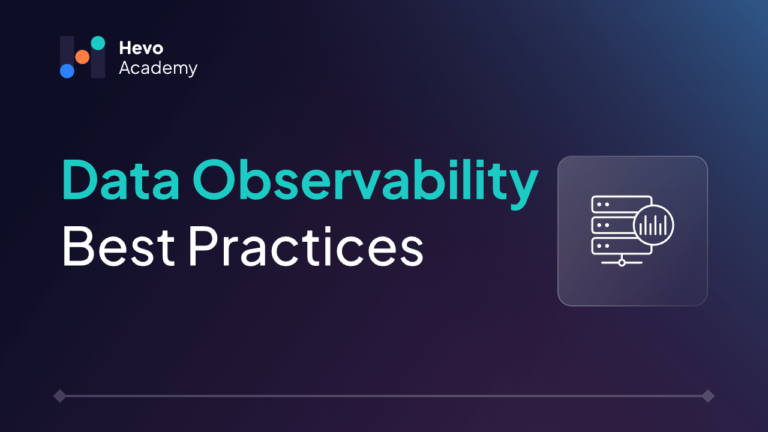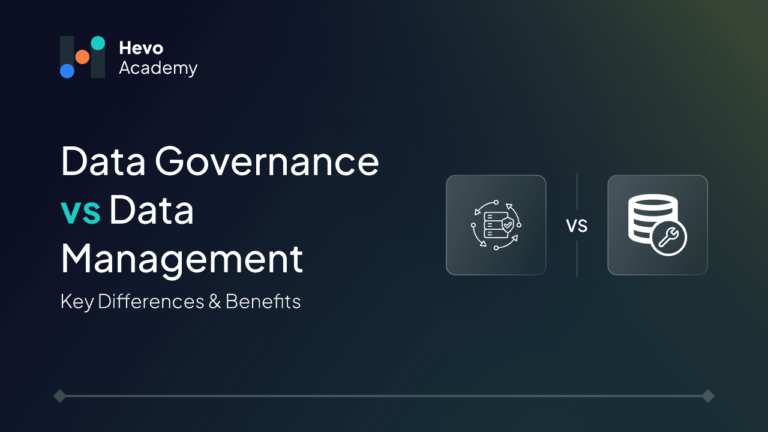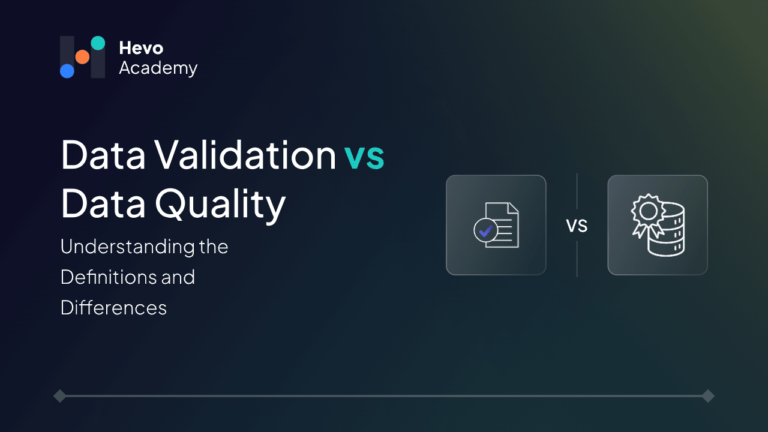In the ever-evolving landscape of data-driven industries, the need for data integrity and quality has become critical. While both data integrity and quality play a major role in maintaining the data, their objectives, responsibilities, and metrics differ.
Table of Contents
This article delves into the nuances of data quality vs data integrity, exploring the factors for maintaining them and the common challenges faced.
Data quality ensures your data is accurate and fit for use, while data integrity guarantees its consistency and reliability. With Hevo, you can:
- Automatically extract and load data from 150+ sources
- Ensure data consistency across systems with real-time syncing
- Maintain complete accuracy and integrity in your data pipelines
- Track data lineage to ensure compliance and trustworthiness
Trusted by companies like Postman and Whatfix, Hevo helps you maintain both data quality and integrity effortlessly. Unlock the power of reliable data with Hevo!
Get Started with Hevo for FreeData Quality Overview
Data quality measures how well the dataset meets your organization’s expectations for accuracy, reliability, consistency, and other key factors. By measuring data quality, you can assess whether your data is trustworthy and ready for analysis.
It is the critical aspect of the data management lifecycle, ensuring that the data used for business decisions is reliable and accurate.
Here are the six key dimensions used to assess data quality.
- Accuracy: Data accuracy measures how well data reflects reality. Imagine an employee receives a promotion and salary but the database still shows the old salary. This means the data is inaccurate.
- Consistency: Data consistency ensures that the same data is stored and correctly formatted across different data sources in your organization. It measures how well your databases are in sync. For example, if an employee’s phone number differs across tables, the data is inconsistent.
- Uniqueness: Data is unique when the dataset contains no duplicate records and information appears only once.
- Completeness: Completeness doesn’t require all data fields of a dataset to be filled, but it should contain all the necessary values to serve its intended purpose. Let’s say we have email ID, first name, last name, and middle name (optional) fields to fill out in a form. The resulting data is still complete if the middle name is missing. However, it is incomplete if the values for the required fields like email id, first name, or last name are missing.
- Validity: Data is valid when presented in the expected format and passes the validation checks.
- Timeliness: Data timeliness ensures the data is available whenever required.
Data Integrity Overview
Data integrity maintains data accuracy, consistency, and reliability throughout its lifecycle.
The two main types of data integrity:
Physical integrity
Physical integrity accounts for the data accuracy and consistency when it is stored and retrieved. It is the organization’s measures to safeguard data from issues like power outages, natural disasters, damaged storage devices, and compromised hardware.
Logical integrity
Logical integrity ensures that data remains consistent and accurate while being used by multiple software systems and databases.
There are four variations of logical integrity:
- Entity integrity: Using primary keys to uniquely identify the records in a relational database, avoiding data duplicacy.
- Domain integrity: It defines the range of acceptable values, their format and data type that can be stored in each field of a database.
- Referential integrity: A set of rules and procedures to maintain data consistency across tables, often implemented in databases through foreign key constraints.
- User-defined integrity: The user can define their own rules and constraints tailored to the specific data use case.
Data Quality vs Data Integrity: Key Differences
Data integrity and quality are crucial to any data-driven organization whose business decisions rely on data. So, understanding data integrity vs. data quality is essential to ensure they are well-implemented in your systems.
| Data integrity | Data quality |
| Data integrity protects data from harm and corruption. | Data quality validates if the data is fit for its intended purpose. |
| Data integrity goes beyond data quality. | Data quality is a subset of data integrity. |
| Implemented through security practices such as encryption, multi-factor authentication, and access controls. | Performs data profiling and addresses inconsistencies and inaccuracies. |
| Ensures data integrity all over its lifecycle. | Data quality is necessary at the moment of use. |
| Data integrity is crucial in critical applications such as financial systems and healthcare databases. | Data quality is maintained for tasks like reporting, analyzing, and decision-making. |
| Prevents unauthorized data modifications to protect from corruption. | Identifying and correcting errors to main data quality. |
Objective
- Data quality: Data quality validates how useful the data is and how well it fits for its intended purpose.
- Data integrity: Data integrity goes a step beyond the data quality, maintaining the intended data quality throughout the entire lifecycle.
Methods to maintain
Data Quality
- Standardize data formats to ensure consistency.
- Establish a robust data governance framework with clear roles and responsibilities.
- Implement data quality tools.
- Cleanse data to address inconsistencies.
- Use the data deduplication process to reduce redundancy.
Data Integrity
- Always validate input data.
- Maintain audit trail and logs.
- Establish role-based controls and permissions for restricted data access.
- Perform regular backups to fight data loss issues.
Use case
- Data quality: High-quality data is essential for analysis, reporting, and business decision-making. For example, customer operations, marketing teams, and sales departments use data to make informed business decisions.
- Data integrity: Data integrity is crucial for critical applications where data accuracy and consistency are of high priority, such as financial systems and healthcare databases.
Timeliness
- Data quality: Accurate, recent, and relevant data is required at the moment of use for real-time decision-making and reporting.
- Data integrity: Maintains the data accuracy and reliability criteria over the entire lifecycle, from data collection to disposal.
Risk management
- Data quality: Reduces the risk of poor decision-making by providing valuable data and preventing customer and operational dissatisfaction.
- Data integrity: Minimizes the risk of accidental data loss, corruption, and unauthorized use of sensitive information.
How to Ensure Data Quality and Data Integrity?
Define data quality and integrity standards.
You should know what you need from your data. Discuss with your data team, stakeholders, and users to understand their expectations and define clear data quality and integrity standards.
Moreover, it would help if you determine key performance indicators and metrics that can be used to validate whether your data follows the predefined data quality and integrity standards.
Implement robust data governance
Data governance establishes the policies, processes, roles, and responsibilities that define how an organization manages its data. Gartner’s research on data governance reinforces that policies and standards are key to aligning data practices with business goals, ensuring both quality and compliance.
Effective data governance ensures that data quality and integrity standards are met, building trustworthy data. It provides the framework to ensure the accuracy, safety, and reliability of data while being used.
Implement data encryption and access controls.
Encryption protects data from being stolen, altered, or deleted by encoding it so that only individuals with the correct encryption keys can access it. This method can secure both data at rest and in transit.
Moreover, defining roles and setting data access permissions based on these roles avoids unauthorized data access and keeps sensitive data safe. These practices can protect your data integrity and quality.
Backup and recovery mechanisms
Store an extra copy of your data in a different location so that you can access it whenever your original data source fails. This saves you from data loss due to hardware failures, natural disasters, or cyber threats.
Today, cloud adoption has made data backups easier. Online backup servers run on client architecture, allowing you to access data even if physical servers fail. If your data infrastructure is already built on the cloud, accessing cloud backup systems is a lot easier.
Use data quality and integrity monitoring tools
It takes a lot of time and effort to manually identify data quality issues and fix them. Data integrity and quality monitoring tools automate the processes and validations needed to maintain accuracy, reliability, and consistency.
Common Challenges and Best Practices to Maintain Data Integrity and Quality
Challenges in Maintaining Data Integrity
- Data loss: Disk crashes, hardware failures, or natural disasters can cause data loss. Regular data backups and automated cloud backup plans can help you recover from such incidents.
- Cyber threats: Cybercriminals can compromise your data integrity for malicious purposes. To protect against such threats, organizations should implement robust security measures, including firewalls, anti-virus software, role-based access control, and intrusion detection systems.
- Integration errors: Data integration is the first step in bringing entire data from various sources to a single place. During the process, data can be corrupted or inconsistent across multiple tables. So, use data mapping and transformation tools to ensure consistency across the systems.
Hevo Data is one of the best data integration and transformation tools that automates the integration process while ensuring 100% data accuracy and reliability.
Challenges in Achieving High Data Quality
- Incomplete data: Incomplete data means your dataset is missing essential information. To address this, enhance your data collection and integration processes.
- Data duplication: Duplicate data leads to redundancy and increased storage costs. To resolve this, identify and delete duplicate records. Additionally, introducing unique primary keys in your dataset is an effective practice to prevent data duplication.
- Outdated information: Irrelevant and old data can’t help you make business decisions. So, implement data update processes and data aging policies to keep your data updated and relevant.
- Inaccurate data: Inaccurate data can lead to inaccurate analytics, resulting in poor decision-making. Resolving this issue involves verifying the reliability of your data sources and setting up data entry validation rules to prevent errors from the source.
- Manual errors: Using standardized templates with predefined fields, data types, and auto-fill options can reduce the number of data entry errors. Additionally, consider automating the data entry process with data quality tools to minimize mistakes further.
Conclusion
While data integrity and data quality are interchangeably used, their primary objectives and techniques differ. That’s why it’s worth knowing the key differences and comparing how they are implemented within your organization.
Implementing the best practices mentioned above ensures integrity and quality within your organizational data. Moreover, Automated data management tools with built-in features for data quality can enhance your business operations by maintaining healthy data overall.
FAQs
1. What is the difference between data integrity and quality?
Data integrity is the process of maintaining consistent and accurate data throughout its lifecycle. At the same time, data quality measures the usefulness of data in making business decisions, analytics, and reporting.
2. Why is data quality important?
Data quality is crucial because high-quality data leads to better business decisions, improved operational efficiency, enhanced customer satisfaction, increasing overall sales and profitability for a company.
3. Why is data integrity crucial?
Data integrity is critical for maintaining the overall trustworthiness of an organization’s data.






